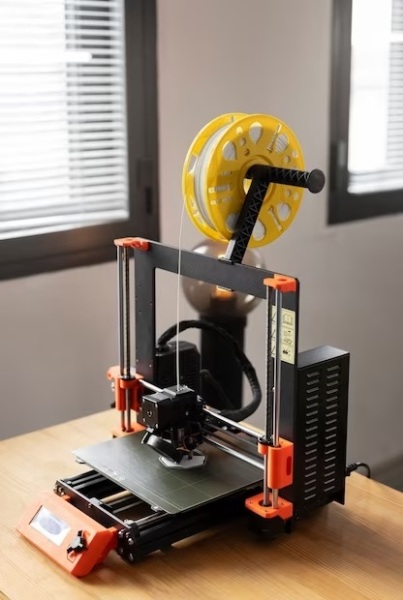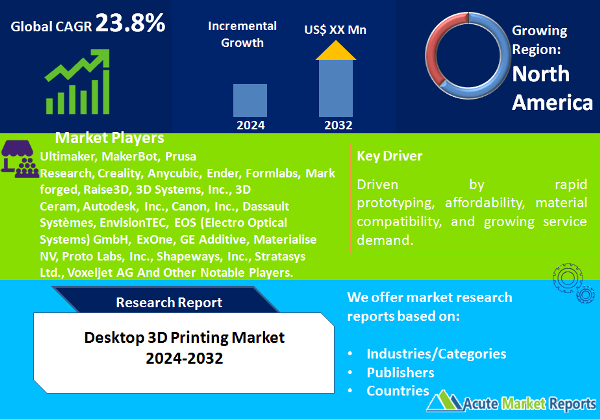
The desktop 3D printing market, a cornerstone of the additive manufacturing landscape, has experienced significant growth and transformation. The desktop 3D printing market is expected to grow at a CAGR of 23.8% during the forecast period of 2025 to 2033, driven by rapid prototyping, affordability, material compatibility, and growing service demand. While the limited build volume poses challenges, the market adapts through technological advancements and expanding service offerings. The segmentation reveals dynamic shifts in component preferences and printing technologies, reflecting the market's responsiveness to user needs. Geographically, Asia-Pacific emerges as a key growth region, emphasizing the global reach of desktop 3D printing. As top players maintain their competitive edge through strategic initiatives, the desktop 3D printing market is poised for continued expansion, playing a pivotal role in reshaping manufacturing paradigms across industries.
Rapid Prototyping and Product Development
The desktop 3D printing market is propelled by the essential driver of rapid prototyping and product development. Evident in the success stories of companies like Ultimaker, MakerBot, and Prusa Research, this driver is underscored by the technology's ability to accelerate the product development cycle. Desktop 3D printers facilitate quick iterations and prototyping, reducing time-to-market for new products. Companies across industries leverage this capability to streamline their design processes, fostering innovation and agility in product development.
Growing Accessibility and Affordability
The increasing accessibility and affordability of desktop 3D printers have contributed significantly to market expansion. As exemplified by Creality, Anycubic, and Ender, companies offering cost-effective desktop 3D printers, this driver is evidenced in the rising adoption by small businesses, educational institutions, and individual enthusiasts. Affordable yet capable desktop 3D printers democratize access to additive manufacturing, enabling a broader range of users to explore and harness the technology for various applications, from educational projects to small-scale production.
Diverse Material Compatibility
The desktop 3D printing market experiences robust growth due to the diverse material compatibility offered by advanced desktop 3D printers. Leading companies like Formlabs, Markforged, and Raise3D showcase this driver through their printers that support a wide range of materials, including engineering-grade plastics, resins, and composite materials. This versatility enhances the market's appeal across industries, from automotive to healthcare, as desktop 3D printers can produce functional prototypes and end-use parts with materials suitable for specific applications.

Restraint
Despite the positive trajectory, a notable restraint in the desktop 3D printing market is the limited build volume of desktop printers. With a constrained build envelope, desktop 3D printers face challenges in producing large-scale prototypes or parts. This limitation hinders their suitability for certain industrial applications requiring substantial build sizes. Evidence of this restraint is observed in user reviews, industry forums, and discussions surrounding the practical constraints imposed by desktop 3D printer build volumes.
Market Segmentation by Component: Hardware Segment Dominates the Market
The market is segmented based on components, including Hardware, Software, and Services. In 2024, the highest revenue was generated by Hardware, reflecting the substantial investment in desktop 3D printers. However, during the forecast period of 2025 to 2033, Services are expected to exhibit the highest CAGR. This shift indicates a growing demand for maintenance, training, and consultancy services as the user base expands and seeks comprehensive support solutions.
Market Segmentation by Technology: Fused Deposition Modeling Dominates the Market
Segmenting the market by technology involves categorizing desktop 3D printers based on their printing methods. Stereolithography, Fuse Deposition Modeling, Selective Laser Sintering, Digital Light Processing, Laminated Object Manufacturing, and other emerging technologies contribute to the diverse landscape. In 2024, the highest revenue was observed in Fused Deposition Modeling, given its popularity and accessibility. However, during the forecast period of 2025 to 2033, Selective Laser Sintering is expected to exhibit the highest CAGR, driven by its capability to process a broader range of materials, including powders with enhanced properties.
North America Remains the Market Leader
Geographically, the desktop 3D printing market exhibits varying trends. In 2024, North America led in both revenue and CAGR, owing to the region's early adoption of additive manufacturing technologies and the presence of key market players. However, Asia-Pacific is expected to experience the highest CAGR during the forecast period, fueled by increasing awareness, rising technological investments, and a growing appetite for affordable desktop 3D printing solutions.
Market Competition to Intensify during the Forecast Period
Top players in the desktop 3D printing market include Ultimaker, MakerBot, Prusa Research, Creality, Anycubic, Ender, Formlabs, Markforged, Raise3D, 3D Systems, Inc., 3D Ceram, Autodesk, Inc., Canon, Inc., Dassault Systèmes, EnvisionTEC, EOS (Electro Optical Systems) GmbH, ExOne, GE Additive, Materialise NV, Proto Labs, Inc., Shapeways, Inc., Stratasys Ltd. and Voxeljet AG. These companies employ diverse strategies, such as continuous product innovation, strategic partnerships, and expanding their service offerings. In 2024, their revenues reflected market leadership, with expectations of sustained growth during the forecast period.
Historical & Forecast Period
This study report represents analysis of each segment from 2023 to 2033 considering 2024 as the base year. Compounded Annual Growth Rate (CAGR) for each of the respective segments estimated for the forecast period of 2025 to 2033.
The current report comprises of quantitative market estimations for each micro market for every geographical region and qualitative market analysis such as micro and macro environment analysis, market trends, competitive intelligence, segment analysis, porters five force model, top winning strategies, top investment markets, emerging trends and technological analysis, case studies, strategic conclusions and recommendations and other key market insights.
Research Methodology
The complete research study was conducted in three phases, namely: secondary research, primary research, and expert panel review. key data point that enables the estimation of Desktop 3D Printing market are as follows:
Market forecast was performed through proprietary software that analyzes various qualitative and quantitative factors. Growth rate and CAGR were estimated through intensive secondary and primary research. Data triangulation across various data points provides accuracy across various analyzed market segments in the report. Application of both top down and bottom-up approach for validation of market estimation assures logical, methodical and mathematical consistency of the quantitative data.
| ATTRIBUTE | DETAILS |
|---|---|
| Research Period | 2023-2033 |
| Base Year | 2024 |
| Forecast Period | 2025-2033 |
| Historical Year | 2023 |
| Unit | USD Million |
| Segmentation | |
Component
| |
Technology
| |
Software
| |
Application
| |
Vertical
| |
Material
| |
|
Region Segment (2023-2033; US$ Million)
|
Key questions answered in this report